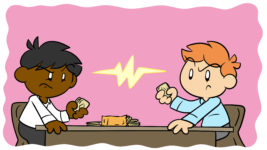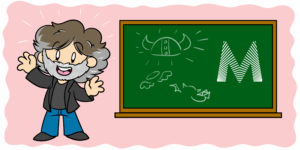It’s common knowledge in any form of writing that you have one paragraph to grab the reader. This is even truer for short story authors, whose choice of form is based on their ability to say a lot with a short amount of writing. Readers are canny, they know that if a short story author can’t get their attention in two sentences, the rest of the story probably won’t change things.
Understanding this duality is key to writing a great short story opening: the first paragraph should not just interest the reader on an emotional level, but show them they’ve found a story worth reading.
So what does your first paragraph need to do to satisfy both conditions? The answer is three things:
- Establish voice
- Imply setting
- Create intrigue
Providing these three factors will grab your reader’s interest as well as advertising your abilities as a storyteller, and the good news is that there are concrete ways to set about all three.
1. Establishing voice
Voice, the lexicon and tone you use to tell a story, is a key tool in writing and one which sustains more experimentation in short fiction than in longer fiction. This is because an interesting narrative voice is difficult to keep totally consistent and may impose restrictions on how certain events can be described. In short fiction, the author is able to plan ahead with more certainty, and obviously the burden of consistency lessens when the piece is shorter. That’s not to say, however, that the use of voice in short stories doesn’t come with its own challenges.
The key challenge in writing a short story opening that drives your reader on is the difference between simply having a voice and establishing that voice in the first few sentences. The difference is in how long it takes a reader to not just recognize that there’s a voice, but to acclimatize to experiencing the story through it.
You need to get your reader to understand the tone and outlook of your story as soon as possible. Ideally by the end of the second sentence the reader should totally understand the way you’ve chosen to tell the story and, just as importantly, that you possess the ability to communicate that to them early. This can be seen in two stories from Neil Gaiman’s Smoke and Mirrors:
What I did on the founders day holiday was, my dad said we were going to have a picnic, and, my mum said where and I said I wanted to go to Ponydale and ride the ponies, but my dad said we were going to the end of the world and my mum said oh god and my dad said now, Tanya, it’s time the child got to see what was what and my mum said no, no, she just meant that shed [sic] thought that Johnsons Peculiar Garden of Lights was nice this time of year.
– Neil Gaiman, ‘When We Went to See the End of the World by Dawnie Morningside, age 11¼’ from Smoke and Mirrors
In this story, the narrator’s age may be communicated in the title, but the reader doesn’t need it to identify the nature of the narration. The first hesitant ‘and’, the overrunning sentences, and the embedded speech are just a few features which quickly establish the voice of the story. This is not a skill reserved for the use of first person storytelling.
Peter Pinter had never heard of Aristippus of the Cyrenaics, a lesser-known follower of Socrates who maintained that the avoidance of trouble was the highest attainable good; however, he had lived his uneventful life according to this precept. In all respects except one (an inability to pass up a bargain, and which of us is entirely free from that?), he was a very moderate man.
– Neil Gaiman, ‘We Can Get Them for You Wholesale’ from Smoke and Mirrors
Here Gaiman uses asides within brackets, unnecessary adjectives, and elongated sentences to produce a whimsical, verbose, yet somewhat academic voice. By the second sentence of ‘We Can Get Them for You Wholesale’ the bracketed aside doesn’t stand out to the reader as unusual, despite straying well outside the bounds of just providing supplementary information from a third party. The voice in which it is appropriate has already been established.
In both stories, the reader immediately understands the approach being taken and how the rest of the story will be told. This is crucial to their decision to continue because while they can’t know how the story will progress, they can judge if they will enjoy hearing it told in the style you’ve introduced.
Once a reader understands something as central as voice, they are ‘reading’ the story. They are no longer assessing whether to begin, but whether to keep going, and that decision is far more likely to go in the writer’s favor. This will be even more true if you can get the reader to engage with not just how the story is told, but what it will be about.
2. Implying setting
In writing terms, ‘setting’ is often used to mean a geographical location, however it’s so much more than that. Setting encompasses the rules and norms of your world. Two stories might be set in the same country at different times, or with characters in different social classes, and be incredibly different reads. Things like the presence of advanced technology or magic also have a huge impact on the reader’s experience of the setting – J.K. Rowling’s Harry Potter series is set in 1990s England, and yet this description alone would be very misleading to a prospective reader.
Implying setting involves giving the reader a few clues as to this wider meaning – a few hints as to the peculiarities of the world, identifying factors that might speak to choice in theme or genre. The first sentence of M.T. Anderson’s ‘Watch and Wake’ tells the reader a lot about the setting of the novel:
At around eight o’clock in the evening, I finally got off the bus at some town. It was the first town in many miles where there were not lines of people waiting around the demon-towers.
– M. T. Anderson, ‘Watch and Wake’ from Gothic! Ten Original Dark Tales
From these passages, we can identify two key details about the setting:
- There is casual travel from town to town via bus. This implies a setting with at least a passing relationship with the modern day, both with its technology and the social reality of living within it.
- The ‘demon-towers’ imply that a degree of mysticism is also present. The fact that they are brought up as an understood presence, the narrator can mention demon-towers with the same assumed familiarity as the bus, tells the reader that this is a world where mundane, relatable life occurs alongside a magical influence.
Through these very simple sentences, the reader knows a great deal about what they can expect from the story, and knows it will probably fall into the subgenre of magical realism. Combined with a sense of voice, the colloquial and dismissive ‘some’ establishing the narrator, the reader now knows a great deal about what they’ll get if they keep reading.
Their desire to know more is tickled, but to really grab their interest you need to turn that desire into a need.
3. Creating intrigue
Creating intrigue is actually the simplest of these steps, as well as being the most effective. It’s a question planted in the reader’s mind which compels them to read on. This is not always distinct from voice or setting – it may be the mystery of the setting that makes the reader want to continue.
In Anderson’s story, the reader’s intrigue comes from the need to understand the relevance of the demon-towers, and the world in which they’re as commonplace as buses. In ‘When We Went to See the End of the World’ the reader similarly wishes to explore a world where Armageddon is both a picnic destination and something a mother might not want her child to see.
Creating intrigue is the simplest step because your story should already have a point of intrigue to use. To identify and use it ask what interest you expect the reader to have in your story. What will they be curious about? Distil that to a question and then do your best to fix that question in the reader’s mind within the first paragraph.
The big three
It can be helpful for your own writing to look for these factors in published short story openings. See how different authors use them, or give prominence to one or another as their style dictates:
Trouble began, and not for the first time, with an apple.
There was a bag of them on Granny Weatherwax’s bleached and spotless table. Red and round, shiny and fruity, if they’d known the future they should have ticked like bombs.
– Terry Pratchett, ‘The Sea and Little Fishes’ from Legends.
Voice: Third person omniscient narrator, but one with a friendly personality and a present but unobtrusive opinion on the events of the story (note ‘should’ rather than ‘would’.) The casual reference to ‘ticked like bombs’ shows that although the story may have a fantasy setting the narration will not be in an archaic or ‘in world’ voice.
Setting: The apple reference is a cheeky allusion to culturally enshrined stories, whether it’s a Snow White reference or a biblical one, so the reader knows to expect something along the lines of a self-aware fairy tale (an impression supported by the character name.)
Intrigue: What trouble?
Combine these three aims in one paragraph and you’ll have a beginning that hooks any reader who could possibly be interested in your story. Not only have you advertised what’s to come, and already put them in a state of reading the story rather than skimming the sentences, you’ve given them a guarantee of your skill as an author.
For more on writing great short fiction check out The 3 types of bravery your short story needs, or if you’re interested in getting published try our guide 10 things you must do to get a short story published.
What’s your favorite short story, and what first attracted your interest in it? Let’s talk in the comments.






5 thoughts on “Short Story Authors, Give Your Opening Paragraph A Little Love!”
Ok, you did it. I bought “Smoke and Mirrors”. But I don’t see “15 Painted Cards from a Vampire Tarot” inside of it! 😉
Hi boostwriter,
I’ve done a spot of research and unfortunately it looks like it might not be included. The Amazon.co.uk description has the addendum ‘Includes extra material exclusive to this Headline Review edition’, suggesting some stories might be left out in other versions, and Wikipedia lists ‘Fifteen Painted Cards…’ as ‘Not in US print version’.
In my copy it begins on page 227, before ‘We Can Get Them for You Wholesale’ and after ‘Bay Wolf’.
It’s difficult to find for free online (I haven’t been able to) but it is available for a small charge through Scribd: http://www.scribd.com/doc/233505925/Fifteen-Painted-Cards-From-a-Vampire-Tarot
Sorry about the mix-up. Hopefully you’ll still find enough in ‘Smoke and Mirrors’ to justify the purchase.
Best,
Rob
Hi boostwriter,
I’d like to apologise again for the mix-up. You’re a valued commenter and member of the Standoutbooks community and I know you bought the book after I’d repeatedly recommended Gaiman, so if it’s okay with you I’d like to send you a €5 Amazon voucher to cover the cost of the Kindle version of the book.
Best,
Rob
Thanks Robert, for the voucher and for your kind email.
There was no need! I believe I will be very happy with Gaiman’s book, with or without the “cards”!
Hi boostwriter,
No problem, that just means you can spend the voucher on something else!
Best,
Rob